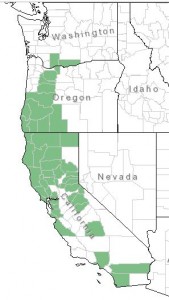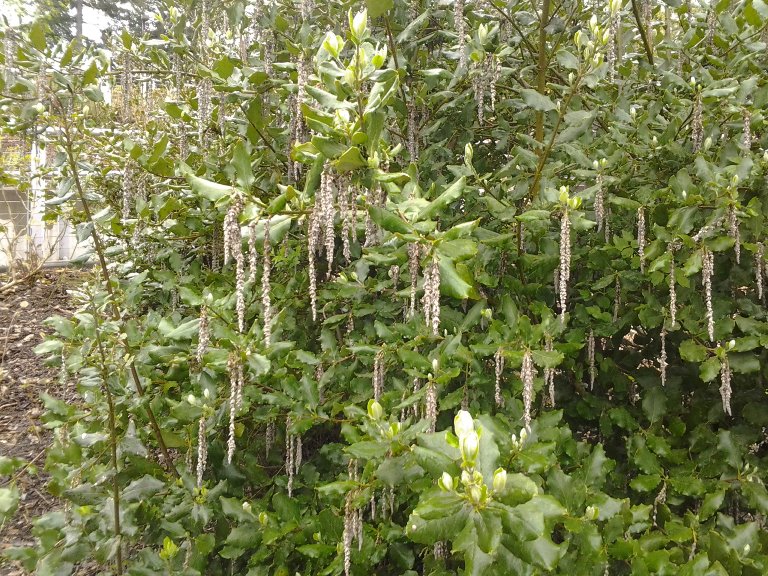Fremont Silktassel The Silk Tassel Family–Garryaceae
Garrya fremontii Torr.
Names: Fremont Silktassel is also known as Bearbrush, Mountain Silktassel, Green-leaf Silktassel, California Feverbush, Quinine Bush, Flannel Bush, or Upland Silktassel Bush. Garrya is named after Nicholas Garry of the Hudson’s Bay Company. This species is named for John Charles Fremont “the Pathfinder,” an explorer and politician of the American West.
Relationships: There are about 18 species of Garrya in North and Central America and the Caribbean; with 8 species from the U.S, mostly limited to the southwest and southern Pacific Coast.
Distribution: Fremont Silktassel reaches the farthest north, barely reaching into Washington along the Columbia River Gorge. In Oregon, it is mostly found west of the Cascades. In California, it is found in the Sierras and coast ranges; with a disjunct population in and around San Diego County. Garrya elliptica, the Coast Silktassel, also native to the coast ranges of Oregon and California, is often grown ornamentally for its long pendulous catkins.
Growth; The Fremont Silktassel grows 3-9 feet (1-3 ft.).
Habitat: It growsin woodlands and chaparral canyons.
Diagnostic Characters: The opposite leaves of Fremont Silktassel are oval-shaped, yellow-green, with light undersides. (In contrast, Garrya elliptica has wavy-edged, dark green leaves with gray, wooly undersides). Male and female flowers are borne on separate plants in yellowish to purple catkin-like racemes, 3-9cm long. Flowers are in cup-like bracts, which are densely silky on female plants. Fruit are round, purple berries that are hairy when young. Young branches are brownish-purple.
In the Landscape: Silktassels are grown ornamentally for their interesting, long, winter-blooming catkins, which are most impressive on male plants. You need both male and female plants to produce the attractive purple fruit. Fremont Silktassel may also be useful as a screen. It is great for dry areas and tolerates heat and cold better than Coast Silktassel
Phenology: Bloom Period: January to May. Fruit ripens: August to December.
Propagation: Seed is best sown as soon as it is ripe in a cold frame. Germination requires overwinter stratification (30-120 days) and may take two or more years to germinate. Seeds may benefit from soaking in 100ppm of gibberellin for 17 hours following the stratification period. Cuttings should be taken from a parent plant of the desired gender. They may be taken of half-ripe wood, with a heel in August, or of mature wood with a heel in December or January. This shrub sprouts quickly from its root crown to recover from wildfire.
Use by People: Early settlers used the leaves of this plant to make a tonic, for fevers, as a substitute for quinine.
Use by Wildlife: Fremont Silktassel is browsed by Mule Deer in winter and spring. The fruit is eaten by songbirds, mountain quail, gray fox, and rodents. It provides good cover for black bear, mule deer, and various birds and small mammals.
Hybrids of Garrya elliptica and G. fremontii are given the name (Garrya x issaquaensis). They have spectacular long catkins like Garrya elliptica but are more cold tolerant. The first known hybrid, ‘Pat Ballard’ was grown from a seed that occurred in its namesake’s garden in Issaquah, Washington. Another cultivar, ‘Carl English’ is named for the Army Corps of Engineers horticulturalist who designed and built the botanical garden at the Hiram S. Chittenden Locks in Ballard, Washington. Another variety, ‘Glasnevin Wine,’ was more recently developed in Ireland.
Links:
Consortium of Pacific Northwest Herbaria
WTU Herbarium Image Collection, Plants of Washington, Burke Museum
Jepson Eflora, University of California
USDA Forest Service-Fire Effects Information System


